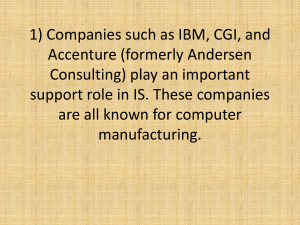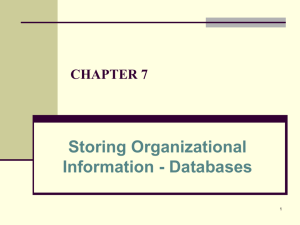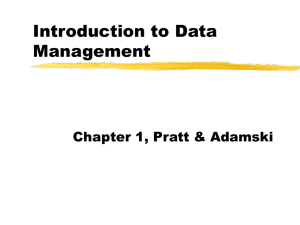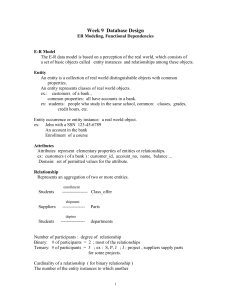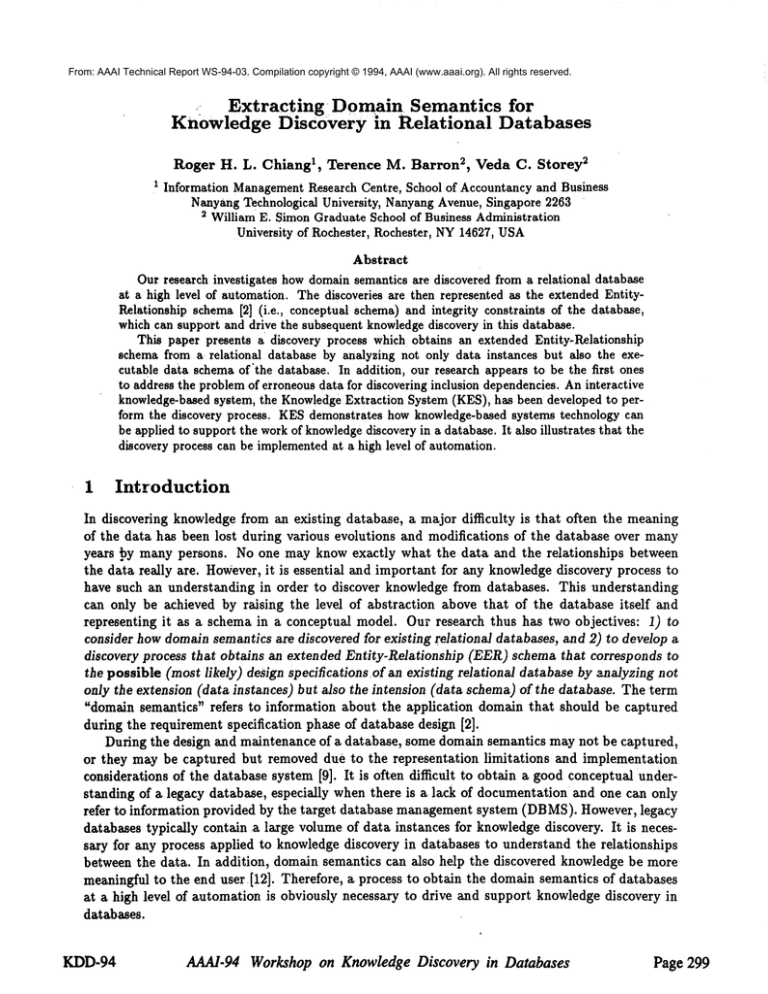
From: AAAI Technical Report WS-94-03. Compilation copyright © 1994, AAAI (www.aaai.org). All rights reserved.
ExtractingDomain
Semantics
KnOwledge Discovery in Relational
for
Databases
Roger H. L. Chiang 1, Terence M. Barron 2, 2Veda C. Storey
1 Information ManagementResearch Centre, School of Accountancyand Business
NanyangTechnological University, NanyangAvenue, Singapore 2263
2 William E. SimonGraduate School of Business Administration
University of Rochester, Rochester, NY14627, USA
Abstract
Our research investigates howdomainsemantics are discovered from a relational database
at a high level of automation. The discoveries are then represented as the extended EntityRelationship schema[2] (i.e., conceptual schema)and integrity constraints of the database,
which can support and drive the subsequent knowledgediscovery in this database.
This paper presents a discovery process which obtains an extended Entity-Relationship
schemafrom a relational database by analyzing not only data instances but also the executable data schemaof’the database. In addition, our research appears to be the first ones
to address the problemof erroneous data for discovering inclusion dependencies.Aninteractive
knowledge-basedsystem, the KnowledgeExtraction System (KES), has been developed to perform the discovery process. KESdemonstrates howknowledge-basedsystems technology can
be applied to support the workof knowledgediscoveryin a database. It also illustrates that the
discovery process can be implementedat a high level of automation.
1
Introduction
In discovering knowledge from an existing database, a major difficulty is that often the meaning
of the data has been lost during various evolutions and modifications of the database over many
years by many persons. No one may know exactly what the data and the relationships
between
the data really are. However, it is essential and important for any knowledgediscovery process to
have such an understanding in order to discover knowledge from databases. This understanding
can only be achieved by raising the level of abstraction above that of the database itself and
representing it as a schema in a conceptual model. Our research thus has two objectives: 1) to
consider how domain semantics are discovered for existing relational databases, and 2) to develop
discovery process that obtains an extended Entity-Relationship (EER) schema that corresponds
the possible (most likely) design specifications of an existing relational database by analyzing not
only the extension (data instances) but also the intension (data schema)of the database. The term
"domain semantics" refers to information about the application domain that should be captured
during the requirement specification phase of database design [2].
During the design and maintenance of a database, some domain semantics may not be captured,
or they may be captured but removed due to the representation limitations and implementation
considerations of the database system [9]. It is often difficult to obtain a good conceptual understanding of a legacy database, especially when there is a lack of documentation and one can only
refer to information provided by the target database managementsystem (DBMS).However, legacy
databases typically contain ,a large volumeof data instances for knowledgediscovery. It is necessary for any process applied to knowledge discovery in databases to understand the relationships
between the data. In addition, domain semantics can also help the discovered knowledge be more
meaningful to the end user [12]. Therefore, a process to obtain the domain semantics of databases
at a high level of automation is obviously necessary to drive and support knowledge discovery in
databases.
KDD-94
AAAI-94 Workshop on Knowledge Discovery
in Databases
Page 299
Several researchers have provided some means for inferring functional and inclusion dependencies from data instances of a relational database, e.g., [1, 10, 11]. However, these dependencies
mainly represent the properties of the physical implementation of the database. In addition, due to
the various semantics degradations during the design and maintenance of a database, any process
for discovering domain semantics must have other knowledge than the functional and inclusion dependencies. For example, knowledge to make the appropriate reverse schema transformation from
the relational data schema to a conceptual one is needed. Database reverse engineering provides
solutions for these problems[5, 9, 13]: It produces a sufficient understanding of an existing database
and its application domain by recovering the domain semantics of an existing database and representing them as a conceptual schema that corresponds to the most likely design specifications of
the database. Thus, in this paper, we discuss how the results of reverse engineering research can
be applied to the discovery of knowledgein a database.
This paper is divided into four sections. Section 2 introduces the discovery process together
with its steps and rules. The architecture of the KnowledgeExtraction System is presented in
Section 3. Weoffer some concluding remarks in Section 4.
The ,Discovery
2
Process
The discovery process deals with rules for discovery, the executable schema and data instances in
the existing database, and the user if necessary. The process is divided into six sequential steps as
shownin Figure 1. Each step is discussed briefly below. Our paper presents several rules used in
the generation and identification steps of the process. Full details of the process and the rules used
can be found in Chiang [5].
Sources for Discovering Domain Semantics. Sources of information for discovering domain
semantics are classified into three categories according to howthey can be obtained. Furthermore,
in order to minimize humaninvolvement, the order of these sources is also the sequence in which
the discovery process obtains the required information.
such as the executable
1. Data dictionary of the target DBMS:Design specifications,
schema, can be obtained directly from the target DBMS’sdata dictionary.
2. Analysis of the executable schema and data instances: Information can be obtained
by analysis of data instances, such as functional and inclusion dependencies, key attributes,
and integrity constraints.
3. The users: User involvement is necessary whenever required information is neither stored
in the target DBMS
nor obtainable by analysis of the executable schema and data instances.
The user can be a database administrator, a database designer or system analyst, or even the
end-user.
2.1
Initialization
of Data Schemas
The information needed about the executable schema includes: relation names, attribute names,
attribute domains (data types), and primary keys. In general, the relation and attribute names can
be obtained directly by querying the data dictionary. However, many current DBMSsdo not store
information about primary keys, e.g., DB2.Thus, the identification rule uses attributes’ properties
(e.g., non-null, uniquely indexed) and names (e.g., names with a prefix or suffix, such as SSN,
Page 300
AAAI.94 Workshop on Knowledge Discovery
in Databases
KDD-94
STEP 1:
Initialization
Specify the key attributes.
Clarify inconsistent attribute names.
STEP 4:
Generation
Infer key-based inclusion dependencies.
Verified Executable Schema
Key-b~edInclusion Dependencies;
Classified Relations and Attributes
1
1
1
STEP 2:
Decomposition
Infer functional dependencies.
Decompose
relations into at ]east 3NF.
STEP 5:
Identification
Makea reverse schema transformation
from a relational to an EERmodel.
1
Third Normal Form (3NF) Relations;
Information about Keys
Domain Semantics and the EERSchema
STEP 3:
Classification
Classify relations and attributes.
STEP 6:
Refinement
& Enhancement
Refine the resulting EERschema.
Recoverdiscarded integrity constraints.
1
1
¯
1
Classified Relations and Attributes
Refined EERSchema;
DomainSemantics; Integrity Constraints
1
Figure 1: The Discovery Process
.ID, #) to find possible key attributes for each relation. Information about possible key attributes
is then provided to the user to aid in specifying the primary key of each relation.
Two types of naming problems are common: homonyms and synonyms. Homonyms occur when
the same name is assigned to attributes
with different
properties;
synonyms occur when different
names are assigned to attributes
with the same domain. The clarification
rule analyzes attributes’
properties for mismatches or similarities
to help the user detect inconsistent situations.
Mismatches
occur when attributes
with the same name have different data types and/or sizes; mismatches of two
attributes
indicate that they may be homonyms. Similarity arises when attributes
with different
names have the same data type and size, or even the same data instances.
Two similar attributes
may be synonyms. Since not all naming inconsistences
can be detected automatically,
the user
must be informed of this phenomenon. After the similar and mismatched attributes
are identified,
the user is asked to confirm the results and perform any necessary renaming.
2.2
Decomposition
of Relations
Thediscovery process decomposesnon-third normalform(3NF) relations 1 of the input database
into at least 3NF,whichallows the identification step to deal with relations whichprimarilycorrespondto one entity type or one relationship type, rather than morethan one entity type or a
mixtureof entity andrelationshiptypes.
1See Elmasriand Navathe[8] for the terminologyof relational databases.
KDD-94
AAAI-94Workshopon KnowledgeDiscoveryin Databases
Page301
RELATION
TYPE
ATTRIBUTES
PERSON: [SSN, name, address]
CUSTOMER:
[SSN, custid, name, sex, credit]
EMPLOYEE:
[SSN, salary, hired-date,
sex, super-ssn]
’ MANAGER:
[SSN, rank, promotion-date, deptno]
~EP~O, dept-name,
location,
ordid]
DEPARTMENT:
PRODUCT:[PRODID, description]
PI~ CE: [PEODID, minprice, maxprice]
MACHINERY:
[MACID, description,
cost]
PROJECT:[PID, projname, budget, dept-name]
DEPEIDENT:[NAME,SSN, sex, bdate, relationship]
ORDER:[PRODID, CUSTID, ordid, order-date,
qty]
WORK-ON:[SSN, PID, start-date]
SCHEDULE:[MACID, ORDID, schedule-time]
EQUIPMENT:
[CAERIERID,PRODID,CUSTID, ship-date]
C0MM-PROJ
: [PID, COMM-PID]
(STRONG)
(STRONG)
(STRONG)
(STRONG)
(STRONG)
(STRONG)
(STRONG)
(STRONG)
(STRONG)
(WEAK)
(REGULAR)
(REGULAR)
(REGULAR)
(SPECIFIC)
(SPECIFIC)
Figure2: A RelationalData Schema
Primary keys and functional dependencies are needed to identify relations that violate the 3NF
requirement. After non-3NF relations are identified,
some standard algorithm (e.g., [3]) can then
used to decompose them into ones that satisfy the 3NF requirement. Previous research has studied
how to infer functional dependencies by analyzing data instances, e.g., [1, 10, 11] using probabilistic
methods, and at least one commercially available tool, DB Designer by Cadre Technologies Inc.,
uses these methods to infer functional dependencies. The data schema shown in Figure 22 is taken
to be the executable schema resulting from these steps. This example is used throughout our paper.
2.3 :Classification
of Relations
andAttributes
Eachrelation
is classified
basedon the comparison
of its key(s)withotherrelations’
keysintoone
and only one of four possiblecategories:
StrongEntityRelation,Weak EntityRelation,Regular
Relationship
Relation,
and SpecificRelationship
Relation.
The attributes
of eachrelationare then
classified
depending
upontheirproperties:
1) whetherit is partof the primarykey;2) whetherthe
non-primary-key
attribute(s)
are the key of anotherrelation.
Eachattribute
is classified
intoone
and only one of five possiblecategories:PrimaryKey Attribute(PKA),DanglingKey Attribute
(DKA), General Key Attribute (GKA), Foreign Key Attribute (FKA), and Non-Key Attribute
(NKA).See Chianget al. [7] for detaileddiscussion
of the classification
schemesof relations
and
attributes.
2.4
Generation
of Inclusion
Dependencies
An inclusion dependency is denoted as A.X ~ B.¥, where A and B are relations,
X is an attribute
or a set of attributes of A, and Y is aa attribute or a set of attributes of B. X and Y must have the
same number of attributes
[41. This inclusion dependency states that the set of values appearing
in A. X must be a subset of the set of values appearing in B.Y.
Inclusion dependencies are generated by the following sequence. First, possible inclusion dependencies are formulated by the formulation rules. Second, invalid dependencies are detected and
~Thenamesof relations and primary keys are shownin capital letters.
Page302
AAA]-94
Workshop
on Knowledge
Discovery
in Databases
KDD-94
eliminated by the rejection rule. Finally, redundant dependencies are detected by the inference rule
and then removed.
2.4.1
Formulation of Possible
Inclusion
Dependencies
In order to avoid formulating many inappropriate dependencies, the rules only propose inclusion
dependencies between relations’ key attributes (primary, candidate, and foreign). These rules are
outlined below:
1. IF: two strong entity relations, A and B, have the same key, X,
THEN:formulate A.X << B.X and B.X ~ A.X.
JUSTIFICATION:
Subtype/supertype relationships and vertically
result in such inclusion dependencies.
fragmented relations
[8]
Consider the strong entity relations PERSON
and EMPLOYEE
in Figure 2. The following inclusion
dependencies are formulated:
PERSON.
[SSN] <<
EMPLOYEE.
[SSN] <<
.
EMPLOYEE.
[SSN’]
PERSON.
[’SSN]
IF: the key, X, of a relation (entity or relationship), A, appears as a foreign key, X, of another
relation (entity or relationship),
THEN:formulate B.X ~ A.X.
JUSTIFICATION:Cases where foreign keys represent binary relationships
between entity
types or between entity and relationship types result in such dependencies.
Consider the relations
cies are formulated:
MANAGER,
DEPARTMENT,
and ORDER.The following inclusion dependen-
MANAGER.[deptno]~ DEPARTMENT.[DEPTN0]
DEPARTMENT.[ordid]<< ORDER. [ordidJ
3. IF: the key, X, of an entity relation, A, appears as the primary key attribute(s) of a weak
entity relation, W,
THEN:formulate W.X ~ A.X.
JUSTIFICATION:
The presence of weak entities’ keys will result in this type of inclusion
dependency. These dependencies are used to determine the owner entity types of weak entities.
4. IF: the key, X, of a relation (entity or relationship), A, appears as the primary key attribute(s)
of a relationship relation (regular or specific),
THEN:formulate R. X << A.X.
JUSTIFICATION:Relationships represented by relationship relations will result in such
inclusion dependencies. These dependencies are used to determine participating entity types
of relationship types identified by relationship relations.
2.4.2
Rejection
of Invalid
Inclusion
Dependencies
Each proposed inclusion dependency is subject to further analysis to validate or reject it. Since
erroneous data instances are to be expected, we use hypothesis testing to avoid rejecting dependencies that should hold but are violated in the database instance due to data errors. For each
proposed inclusion dependency, A.X << B.Y, two hypotheses are formulated:
KDD-94
AAA1-94 Workshop on Knowledge Discovery
in Databases
Page 303
H0: A.X ~ B.Y holds in reality.
Hx: A.X ~ B.Y does not hold.
The parameters used are defined as follows:
r =
a =
b=
e=
true error
numberof
number of
numberof
rate in the data in question
data instances in A. X
data instances in B. Y
data instances, E, that appear in A. X but not in B. ¥
The reverse engineering process analyzes data instances of A. X and B. ¥ to obtain the values of a,
b, and e. The null values in A. X and B. Y are not counted in a, b, and e.
Under the null hypothesis, ~ is a point estimator of the true but unknownerror rate, r. (Some
types of data entry errors will not be included in this, such as whendata entered for A. X corresponds
to an existing value of B.¥, but the wrong tuple is referenced.) A confidence interval of any
desired confidence level can then be constructed around ~ using standard methods for estimating
proportions (see [14], p. 196.) If the upper bound of this interval is larger than any error rate
the user is willing to accept as plausible, then the null hypothesis is rejected; otherwise it cannot
be rejected. (Clearly, if the user specifies r = 0, the presence of any erroneous data will cause
the inclusion dependency to be rejected, so that error-free data is handled as a special case.) As
is standard in hypothesis testing, a type-one error occurs when a valid inclusion dependency is
rejected, while a type-two error occurs whenan invalid inclusion dependency is not rejected. The
output of the discovery process thus needs to be reviewed and verified by the user, and problems
arising from such errors might be found then. Note that failure to reject an inclusion dependency,
even whenit is fully satisfied by the current database instance, does not guarantee that it holds in
all possible database states.
2.4.3
Removal of Redundant Inclusion
Dependencies
Redundant inclusion dependencies need to be detected and removed, because they can lead to
redundant relationships, or identifying the wrongparticipating entity type for a relationship type,
or both. This inference rule is used to detect redundant dependencies:
IF: A.X ~ B.X and B.Y ~ C.¥ hold, and Y is a subset of X,
THEN: A.¥ ~ C.Y is redundant.
JUSTIFICATION:
It is based on the projection and transitivity
inclusion dependencies.
2.5
Identification
of Entity
and Relationship
properties
of
Types
Identification rules encode knowledge necessary for performing reverse schema transformations from
the relational data schema to the EERschema. Table 1 summarizes the reverse schema transformations based on classified relations and attributes. Identification rules are used to identify entity
types first so relationship types amongthem can be identified thereafter. Several identification
rules are discussed in detail below.
Page 304
AAAI.94 Workshop on Knowledge Discovery
in Databases
KDD-94
Table 1: Identification of EERstructures by classified relations and attributes.
Relation
STRONG
Attribute
i " ’ i .~.Modelling
identifies aStructures
strong’entity~ the
type,EER
or Model
PKA
FKA
NKA
WEAK
PKA
DKA
FKA
NKA
REGULAR
PKA
FKA
NKA
SPECIFIC
PKA
GKA
FKA
NKA
¯ Identifies
a relationship
typewithitsownkey
Keyforthestrong
entity
type
Identifies
a binary
relationship
type
DescriPtive
attribute
fora relationship
oranentity
type
identifies a weak entity type
Relates a weakentity type with its identifying owner(s)
Keyfor the weakentity type
Identifies a binary relationship type
Descriptive attribute for a relationship or an entity type
Identifies a relationsh’ip type
Determinesparticipating entity types
Identifies a binary relationship type
Descript!ve attribute for a relationship type
Identifies a relationship type
Determinesparticipating entity types
Identifies newstrong entity type(s)
Identifies a binary relationship type
Descriptiveattribute for a relationship type
Strong Entities.
IF: a relation, A, is classified as a strong entity relation,
THEN:a) identify a strong entity type, A, and b) assign primary and candidate keys
eft to A.
JUSTIFICATION:According to Table 1, a strong entity relation can be converted
into one of two EERstructures. Since a relationship type with its ownkey can also be
considered as an entity type, all strong entity relations are identified as strong entity
types of the EERmodel.
For example, CUSTOHER,
a strong entity relation, is converted into a strong entity type, Customer.
The primary and candidate keys of CUSTOMER
(i.e., SSN and custid), are assigned as the key
attributes of Customer.
Is-a relationships.
Is-a relationships are identified using the following rule:
IF:
1. two strong entity types, A and B, have the same key, X, and
2. t.X ~ B.X holds, but B.X ,~ A.X does not,
THEN:identify an is-a relationship between A and B.
JUSTIFICATION:
The first condition is the heuristic used to detect a subtype/supertype
relationship between two strong entity types having the same key. The second condition
employs an inclusion dependency to confirm the existence of an is-a relationship.
If two entity types, A and B, have the same key and the same set of data instances in their keys,
then the user is asked to specify the proper type of inclusion relationship between A and B, such
as A is-a B, A is-a-kind-of B, A is-part-orB, A has B, etc.
KDD-94
AAAI-94 Workshop on Knowledge Discovery
in Databases
Page 305
Relationships identified by relationship relations. The identification
rule identifies
tionship type amongthe participating entity types for each relationship relation.
a rela-
IF: there is a relationship relation, R,
THEN:identify a relationship type, It, with its participating entity types.
IF:
1. the key, X, of an entity type, A, appears as a primary key attribute(s)
of the
relationship relation, R, and
2. R.X ~ A.X holds,
THEN:A is a participating entity type of R.
IF: more than one entity type, A, satisfies the above conditions,
THEN:the user must confirm the exact participating entity type.
JUSTIFICATION:Conditions 1 and 2 above are necessary conditions for A to be a
participating entity type of R. If A is not unique in satisfying these conditions, then
further information which can only be supplied by the user is needed.
Consider WORK-0N
in Figure 2. Suppose the following two inclusion dependencies hold:
WORK-ON.[SSN] ,~ EMPLOYEE.
[SSN]
WORK-ON.[PID]~ PROJECT.[PID].
The reverse engineering process identifies
Project, called WORK-ON.
a binary relationship
Relationships identified by foreign keys. The identification
ship type for each foreign key.
type between Employee and
rule identifies
a binary relation-
IF: a foreign key, X, in a relation (entity or relationship), B, appears as a key, X,
tmother relation (entity or relationship),
THEN:identify a binary relationship type. One participating entity type is identified
by the relation containing the foreign key (i.e., B). The other is identified by the relation
whosekey is the same as the foreign key (i.e., A).
JUSTIFICATION:
The foreign keys in the relational databases are used to represent
one-to-many binary relationship types. Therefore, such an identification is the most
appropriate transformation of a foreign key. The name of this relationship type must
be provided by the user.
Consider the foreign key deptno in MANAGER
and the inclusion dependency,
~NAGER.[deptno] ~ DEPART~NT.
[DF_~TN0]. The process identifies
a binary relationship
between the entity types Manager and Department, for which the user must provide a name,
for example MANAGE.
2.6
Refinement
and Enhancement.
The resulting EERschema is then refined and enhanced to make it semantically richer and more
natural. First, the schema may contain EERstructures that are identified by relational structures
resulting from performance optimization (e.g., vertical fragmentation of relations). Second, design
problems implicitly represented in the executable schema can be detected by the resulting EER
schema. Finally, the resulting EERschema and the inclusion dependencies are used to declare
integrity constraints for the existing database.
Page 306
AAAI.94 Workshop on Knowledge Discovery
in Databases
KDD-94
Key and Entity Integrity
Constraint.
IF: X is a key (primary or candidate) of relation
THEN:X must contain unique values in any instance of A.
IF: X is also the primary key,
THEN:X must contain non-null values in any instance of A.
Domain and Referential
Integrity
Constraint.
IF: the key, X, of a relation, a, appears as either:
1. the foreign key, X, of another relation, B,
2. the key of a strong entity relation, B, or
3. the primary key attributes of a relationship relation, R,
THEN:
(a) the foreign key X in B and/or the primary key attribute(s) X in R must
the same’data type and size as X in A, and (b) each data instance of the foreign key
in B and/or the primary key attribute(s) X in B and R must refer to the data instance
of X in an existing tuple of A.
3
The Knowledge
Extraction
System
The Knowledge Extraction System (KES), an interactive
knowledge-based system, has been developed to perform the discovery process. KESillustrates
how the integration of database and
knowledge-based systems can support the work of knowledge discovery in relational databases.
Currently, KESperforms the last four steps of the discovery process.
KES is written in Arity Prolog and Microsoft C, integrated with the ORACLE
RDBMS;it
runs on an IBMPC. It has six basic components. Figure 3 shows the architecture
of KESand
the predominant information flows amongits components. See Chiang [6] for detailed discussion
of KE~. Figure 4 shows the EERdiagram representing the domain semantics discovered by KES
from Figure 2.
Queried
Domain
UserInterface
(PROLOG)
l- Request
I
USERS
! (PROLOG)
Queries
I
System
Interface
(c)
ueried
IQ
Queries
I
Results
Results
,
(EER Schema)
RDBMS
(ORACLE)
Knowledge
Discovery
Rules
IlOi
c°ve
e
Base
)
Dta
(Existing)
Database
Figure 3: Architecture
KDD-94
of the KnowledgeExtraction System
AAAI-94 Workshop on Knowledge Discovery
in Databases
Page 307
Person
Project
M
[
Employee
Ma,nager [
"1
r
!
I
I
i
L
I
Product
i 1
N[ Customer
i
I
I
.I
Order
I
Figure 4: A portion of the EER schema obtained from Figure 2 by KES. Strong entity types
are shown as rectangles, weak entity types are shown as double rectangles, relationship types
are represented by diamonds, and composite entity types are represented by dashed boxes. The
cardinality ratio of a binary relationship is shownby a pair of numbers along with the diamond.
Page 308
AAAI-94 Workshop on Knowledge Discovery
in Databases
KDD-94
Concluding Remarks
4
Our research investigates howoriginal design specifications of an exiting relational database can
be recovered by analysis of data instances and the executable schema. Wepresent a process for
discovering domain semantics for existing databases. These discoveries are represented in an EER
schema that can provide a better interpretation of data with respect to the application domain in
order to support subsequent knowledgediscovery processes. Since the original design specifications
are normally either unobtainable or uninteresting due to the various semantic degradations during
the design and maintenance of a database, the EERdiagram resulting from the discovery process
should be considered as the best guess (most likely) design specifications as to what a rational
designer would use the relational structures appearing in the database to represent. The discovery
process uses discovery rules and the executable schemaand data instances of the existing database,
and it deals with the user if necessary. The KnowledgeExtraction System, an interactive knowledgebased system, has been developed to demonstr~tte this discovery process can be implemented at a
high level of automation with the application of knowledge-based systems technology. The results
of our research should have immediate practical applications in research on knowledge discovery in
databases.
References
Akutsu,
[1]
T. and Takasu, A., "Inferring Approximate Functional Dependencies from Example
Data," in Proc. of AAAI-93 Workshop on Knowledge Discovery in Databases, The AAAI
Press, July 1993, pp.138-150.
Batini,
[2]
C., Ceri, S. and Navathe, S.B., Conceptual Database Design: An Entity-Relationship
Approach, The Benjamin~Cummings Publishing CompanyInc., 1992.
B’~rnstein,
[3]
P.A., "Synthesizing Third Normal Form Relations from Functional Dependencies,"
ACMTransactions on Database Systems 1:4, December 1976, pp. 272-298.
[4] Casanova, M.A., Fagin, R. and Papadimitriou, C., "Inclusion Dependencies and Their Interaction with Functional Dependencies," Journal of Computer and System Sciences 28:1, February
1984, pp. 29-59.
[5] Chiang, R.H.L., "Reverse Engineering of Relational Databases: Extraction of Domain Semantics," unpublished Ph.D. thesis, University of Rochester, May1993.
[6] Chiang, R.H.L., "A Knowledge-BasedSystem for Performing Reverse Engineering of Relational
Databases," Decision Support Systems, Forthcoming, March 1995.
[7] Chiang, R.H.L., Barron, T.M. and Storey, V.C., "Reverse Engineering of Relational Database
of Relational Databases: Extraction of an EERModel From a Relational Database", Data &
Knowledge Engineering, Vol 12, No, 2, March 1994, pp. 107-142.
[8] Elmasri, R. and Navathe, S.B., Ftmdamentals of Database Systems, The Benjamin/Cummings
Publishing CompanyInc., Second Edition, 1994.
[9] Hainaut, J-L., "Database Reverse Engineering: Models, Techniques and Strategies," in Proc.
of the Tenth International Conference on Entity-Relationship Approach, 1991, pp. 729-741.
KDD-94
AAAI-94 Workshop on Knowledge Discovery
in Databases
Page 309
[10] Kantola, M., Mannila, H., Raiha, K. and Siirtola, H., "Discovering functional and inclusion
dependencies in relational databases," International Journal of Intelligent Systems, Vol. 7,
1992, pp. 591--607.
[11] Kivinen, J. and Mannila, H., "Approximate Dependency Inference from Relations,"
Theory, ICDT92, Fourth International Conference, 1992, pp. 86-98.
Database
[12] Frawley, W.J., Piatetsky-Shapiro, G. and Matheus, C.J., "KnowledgeDiscovery in Databases:
An Overview," AI Magazine 13:3, 1992, pp. 57-70.
[13]Premerlani,
W.J. and Blaha, M.R., "An Approach for Reverse Engineering of Relational
Databases," Proc. of the Workshop on Reverse Engineering, 1993 International Conference
on Software Engineering, Baltimore, May1993.
[14] Spiegel, M. R., Probability and Statistics,
McGraw-Hill,1975.
%
Page 310
AAAI-94 Workshop on Knowledge Discovery
in Databases
KDD-94



